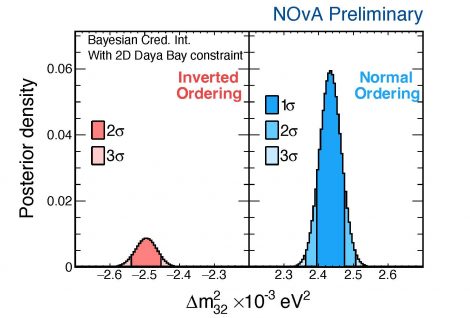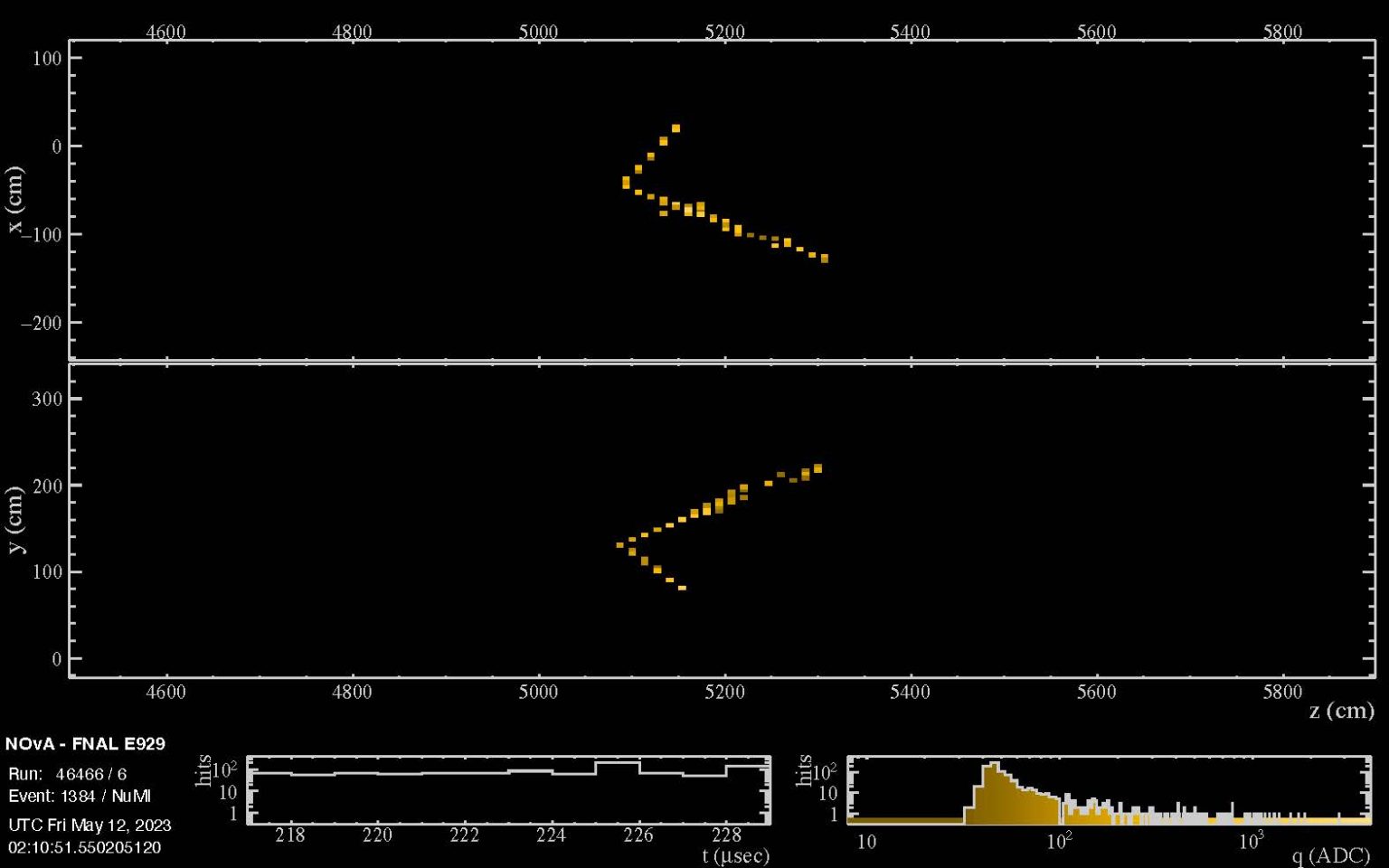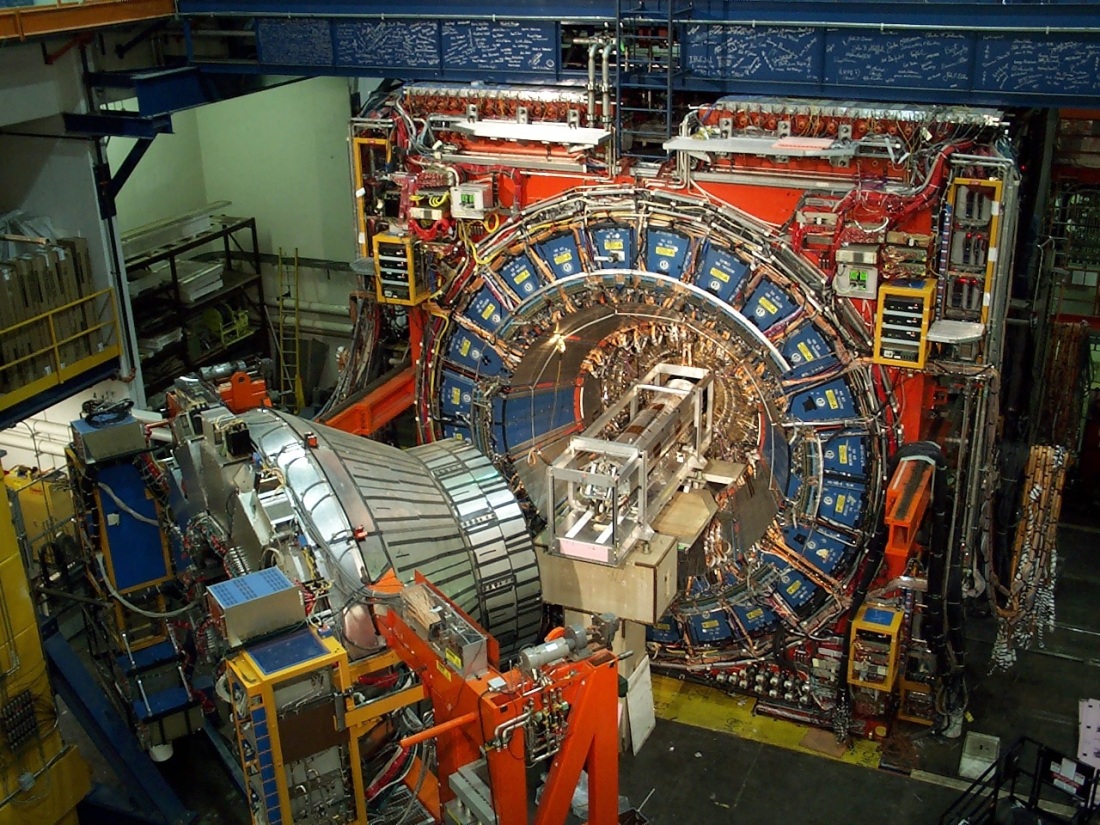
FNAL Art Image by Angela Gonzales
From The DOE’s Fermi National Accelerator Laboratory-an enduring source of strength for the US contribution to scientific research worldwide.

6.18.24
Tracy Marc
The international NOvA collaboration presented new results at the Neutrino 2024 conference in Milan, Italy, on June 17. The collaboration doubled their neutrino data since their previous release four years ago, including adding a new low-energy sample of electron neutrinos. The new results are consistent with previous NOvA results, but with improved precision. The data favor the “normal” ordering of neutrino masses more strongly than before, but ambiguity remains around the neutrino’s oscillation properties.
The latest NOvA data provide a very precise measurement of the bigger splitting between the squared neutrino masses and slightly favor the normal mass ordering. That precision on the mass splitting means that, when coupled with data from other experiments performed at nuclear reactors, the data favor the normal ordering at almost 7:1 odds. This suggests that neutrinos adhere to the normal ordering, but physicists have not met the high threshold of certainty required to declare a discovery.

Probability distributions for the value of the larger neutrino mass squared splitting from NOvA data when antineutrino measurements at nuclear reactors are included. The normal (blue) mass ordering is preferred over the inverted (red) one by a factor of 7:1. Credit: NOvA Collaboration.
NOvA, short for NuMI Off-axis νe Appearance, is an experiment managed by the U.S. Department of Energy’s Fermi National Accelerator Laboratory, located outside of Chicago. Fermilab sends a beam of neutrinos 500 miles north to a 14,000-ton detector in Ash River, Minnesota. By measuring the neutrinos and their antimatter partners, antineutrinos, in both locations, physicists can study how these particles change their type as they travel, a phenomenon known as neutrino oscillation.

NOvA aims to learn more about the ordering of neutrino masses. Physicists know that there are three types of neutrinos with different masses, but they don’t know the absolute mass, nor which is heaviest. Theoretical models predict two possible mass orderings, normal or inverted. In the normal ordering, there are two light neutrinos and one heavier neutrino; in inverted, there is one light neutrino and two heavier ones.
“Getting additional information from reactor experiments enhances our knowledge of the mass ordering and gets us close to exciting territory,” said Erika Catano-Mur, a postdoctoral research associate at William & Mary and co-convener of the analysis. “We almost have an answer to one of those big questions that we have in neutrino physics. But we’re not there yet.”
The solution to neutrino oscillation remains ambiguous in the new results. Physicists don’t currently have enough data to disentangle two effects on the oscillation: mass ordering and a property called charge parity violation. The collaboration observed a moderate amount of oscillation that could be explained in either mass ordering scenario with different amounts of CP violation, so they cannot tease apart the mass ordering and CP violation. However, the physicists were able to rule out specific combinations of the two properties.

An electron neutrino scattering event from the latest NOvA dataset. The brighter the yellow pixels, the more energy that was deposited. Physicists know this is a neutrino because it occurs in time with the beam pulse, “points” back to Fermilab, and occurs far away from the edges of the detector, meaning whatever initiated the activity had to travel through a lot of matter without leaving a trace. The electron in the final state is initially track-like, but then develops into an electromagnetic cascade. Credit: NOvA Collaboration.
“It really takes more than one measurement for us to learn everything we need to know,” said Jeremy Wolcott, a postdoctoral fellow at Tufts University, one of NOvA’s analysis coordinators and the speaker at the conference.
“NOvA is an important player in this because there are unique aspects to all of the various experiments that are trying to measure the same parameters,” said Wolcott. “We’re starting to see a picture come together, but it’s murky. Having different measurements that all work together is really important.”
The NOvA experiment started taking data in 2014 and will continue running through early 2027, during which time the collaboration hopes to double their antineutrino dataset. They also continue to implement analysis improvements to maximize the sensitivity of the experiment.
Their efforts are also paving the way for future experiments that will seek to contribute even more to solving the mysteries around neutrino properties.
“We want to make the most that we can out of the data,” said Catano-Mur. “What we learn — not only from the results themselves, but in the process, what we’re learning about the analysis methods — is going to be useful for the next generation of experiments that right now are under construction.”
Still, NOvA has the potential to reveal more about the elusive neutrino. “This result is an important reminder that the current generation of experiments, including NOvA, continues to collect valuable data and produce physics insights,” said Zoya Vallari, postdoctoral researcher at CalTech and co-convener of the analysis. “They are our best shot at a discovery right now.”
The NOvA collaboration is made up of more than 200 scientists from 50 institutions in eight countries. With the additional data and further analysis improvements, NOvA will bring physicists closer to understanding the identity-changing behavior of neutrinos.
See the full article here .
Comments are invited and will be appreciated, especially if the reader finds any errors which I can correct.

five-ways-keep-your-child-safe-school-shootings
Please help promote STEM in your local schools.
The DOE’s Fermi National Accelerator Laboratory, located just outside Batavia, Illinois, near Chicago, is a United States Department of Energy national laboratory specializing in high-energy particle physics. Since 2007, Fermilab has been operated by the Fermi Research Alliance, a joint venture of The University of Chicago, and the Universities Research Association. Fermilab is a part of the Illinois Technology and Research Corridor.
Fermilab’s Tevatron was a landmark particle accelerator; until the startup in 2008 of the Large Hadron Collider(CH) near Geneva, Switzerland, it was the most powerful particle accelerator in the world, accelerating antiprotons to energies of 500 GeV, and producing proton-proton collisions with energies of up to 1.6 TeV, the first accelerator to reach one “tera-electron-volt” energy. At 3.9 miles (6.3 km), it was the world’s fourth-largest particle accelerator in circumference. One of its most important achievements was the 1995 discovery of the top quark, announced by research teams using the Tevatron’s CDF and DØ detectors. It was shut down in 2011.
__________________________________________________________
[Earlier than the LHC at CERN, The DOE’s Fermi National Accelerator Laboratory had sought the Higgs with the Tevatron Accelerator.




But the Tevatron could barely muster 2 TeV [Terraelectron volts], not enough energy to find the Higgs. CERN’s LHC is capable of 13 TeV.
Another possible attempt in the U.S. would have been the Super Conducting Supercollider.

Fermilab has gone on to become a world powerhouse in neutrino research with the LBNF/DUNE project which will send neutrinos 800 miles to SURF-The Sanford Underground Research Facility in Lead, South Dakota.
_________________________________







_________________________________
In addition to high-energy collider physics, Fermilab hosts a series of fixed-target and neutrino experiments, such as The MicroBooNE (Micro Booster Neutrino Experiment),


NOνA (NuMI Off-Axis νe Appearance)




Seaquest

Completed neutrino experiments include MINOS (Main Injector Neutrino Oscillation Search), MINOS+, MiniBooNE and SciBooNE (SciBar Booster Neutrino Experiment).
The MiniBooNE detector was a 40-foot (12 m) diameter sphere containing 800 tons of mineral oil lined with 1,520 phototube detectors. An estimated 1 million neutrino events were recorded each year.
SciBooNE sat in the same neutrino beam as MiniBooNE but had fine-grained tracking capabilities. The NOνA experiment uses, and the MINOS experiment used, Fermilab’s NuMI (Neutrinos at the Main Injector) beam, which is an intense beam of neutrinos that travels 455 miles (732 km) through the Earth to the Soudan Mine in Minnesota and the Ash River, Minnesota, site of the NOνA far detector.
The ICARUS neutrino experiment was moved from CERN to Fermilab.


In the public realm, Fermilab is home to a native prairie ecosystem restoration project and hosts many cultural events: public science lectures and symposia, classical and contemporary music concerts, folk dancing and arts galleries. The site is open from dawn to dusk to visitors who present valid photo identification.
Asteroid 11998 Fermilab is named in honor of the laboratory.








Weston, Illinois, was a community next to Batavia voted out of existence by its village board in 1966 to provide a site for Fermilab.
The laboratory was founded in 1969 as the National Accelerator Laboratory; it was renamed in honor of Enrico Fermi in 1974. The laboratory’s first director was Robert Rathbun Wilson, under whom the laboratory opened ahead of time and under budget. Many of the sculptures on the site are of his creation. He is the namesake of the site’s high-rise laboratory building, whose unique shape has become the symbol for Fermilab and which is the center of activity on the campus.
After Wilson stepped down in 1978 to protest the lack of funding for the lab, Leon M. Lederman took on the job. It was under his guidance that the original accelerator was replaced with the Tevatron, an accelerator capable of colliding protons and antiprotons at a combined energy of 1.96 TeV. Lederman stepped down in 1989. The science education center at the site was named in his honor.
The later directors include:
John Peoples, 1989 to 1996
Michael S. Witherell, July 1999 to June 2005
Piermaria Oddone, July 2005 to July 2013
Nigel Lockyer, September 2013 to the present
Fermilab continues to participate in the work at the Large Hadron Collider (LHC); it serves as a Tier 1 site in the Worldwide LHC Computing Grid and hosts 1000 U.S. scientists who work on the CMS project.




With the newly completed assembly, the PIP-II team concludes a long process that began in earnest in 2018 with the development of the cryomodule’s design, led by Fermilab. The lab’s earlier development of the lower-frequency SSR1 cryomodule heavily influenced this design.
In this final section of the linac, these superconducting cryomodules will power beams of protons to the final energy of 800 million electronvolts, or MeV, before the protons exit the linac. From there, the proton beam will transfer to the upgraded Booster and Main Injector accelerators, where it will gain more energy before being turned into a beam of neutrinos. These neutrinos will then be sent on a 1,300-kilometer journey through Earth to the Deep Underground Neutrino Experiment and the Long Baseline Neutrino Facility in Lead, South Dakota.
Completed just before work began on the HB650 cryomodule, the SSR1 cryomodules will make up a different part of the new linac.





